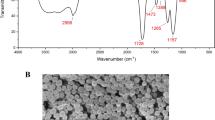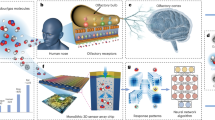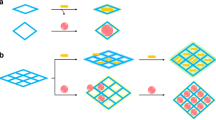Abstract
Array-based vapour-sensing devices are used to detect and differentiate between chemically diverse analytes. These systems—based on cross-responsive sensor elements—aim to mimic the mammalian olfactory system1,2,3 by producing composite responses unique to each odorant. Previous work has concentrated on a variety of non-specific chemical interactions4,5,6,7,8,9,10,11 to detect non-coordinating organic vapours. But the most odiferous, toxic compounds often bind readily to metal ions. Here we report a simple optical chemical sensing method that utilizes the colour change induced in an array of metalloporphyrin dyes upon ligand binding while minimizing the need for extensive signal transduction hardware. The chemoselective response of a library of immobilized vapour-sensing metalloporphyrin dyes permits the visual identification of a wide range of ligating (alcohols, amines, ethers, phosphines, phosphites, thioethers and thiols) and even weakly ligating (arenes, halocarbons and ketones) vapours. Water vapour does not affect the performance of the device, which shows a good linear response to single analytes, and interpretable responses to analyte mixtures. Unique colour fingerprints can be obtained at analyte concentrations below 2 parts per million, and responses to below 100 parts per billion have been observed. We expect that this type of sensing array will be of practical importance for general-purpose vapour dosimeters and analyte-specific detectors (for insecticides, drugs or neurotoxins, for example).
This is a preview of subscription content, access via your institution
Access options
Subscribe to this journal
Receive 51 print issues and online access
$199.00 per year
only $3.90 per issue
Buy this article
- Purchase on Springer Link
- Instant access to full article PDF
Prices may be subject to local taxes which are calculated during checkout




Similar content being viewed by others
References
Dryer, L. & Berghard, A. Odorant receptors: a plethora of G-protein-coupled receptors. Trends Pharmacol. Sci. 20, 413–417 (1999).
Lancet, D. & Ben-Arie, N. Olfactory receptors. Curr. Biol. 3, 668–674 ( 1993).
Axel, R. The molecular logic of smell. Sci. Am. 273, 154–159 (1995).
Freund, M. S. & Lewis, N. S. A chemically diverse conducting polymer-based “electronic nose”. Proc. Natl Acad. Sci. USA 92, 2652–2656 ( 1995).
Lonergan, M. C. et al. Array-based vapor sensing using chemically sensitive, carbon black-polymer resistors. Chem. Mater. 8, 2298–2312 (1996).
Walt, D. R. Fiber optic imaging sensors. Acc. Chem. Res. 31, 267–278 (1998).
Dickinson, T. A., White, J., Kauer, J. S. & Walt, D. R. A chemical-detecting system based on a cross-reactive optical sensor array. Nature 382, 697–700 (1996).
Heilig, A. et al. Gas identification by modulating temperatures of SnO2-based thick film resistors. Sens. Actuators B 43, 45–51 (1997).
Gardner, J. W., Shurmer, H. V. & Tan, T. T. Application of an electronic nose to the discrimination of coffees. Sens. Actuators B 6, 71– 75 (1992).
Crooks, R. M. & Ricco, A. J. New organic materials suitable for use in chemical sensor arrays. Acc. Chem. Res. 31, 219–227 (1998).
Grate, J. W. & Abraham, M. H. Solubility interactions and the design of chemically selective sorbent coatings for chemical sensors and arrays. Sens. Actuators B 3, 85– 111 (1991).
Gelperin, A., Flores, J. & Raccuia-Behling, F. Nitric oxide and carbon monoxide modulate oscillations of olfactory interneurons in a terrestrial mollusk. J. Neurophysiol. 83, 116–127 ( 2000).
Baron, A. E., Danielson, J. D. S., Gouterman, M., Wan, J. R. & Callis, J. B. Submillisecond response times of oxygen-quenched luninescent coatings. Rev. Sci. Instrum. 64, 3394–3402 (1993).
Lee, W. et al. Halogenated platinum porphyrins as sensing materials for luminescence-based oxygen sensors. J. Mater. Chem. 3, 1031– 1035 (1993).
Vaughan, A. A., Baron, M. G. & Narayanaswamy, R. Optical ammonia sensing films based on an immobilized metalloporphyrin. Anal. Commun. 33, 393– 396 (1996).
Brunink, J. A. J. et al. The application of metalloporphyrins as coating material for quartz microbalance-based chemical sensors. Anal. Chim. Acta 325, 53–64 (1996).
Di Natale, C. et al. The exploitation of metalloporphyrins as chemically interactive material in chemical sensors. Mater. Sci. Eng. C 5, 209–215 (1998).
Blauer, G. & Sund, H. (eds) Optical Properties and Structure of Tetrapyrroles (de Gruyter, Berlin, 1985).
Nappa, M. & Valentine, J. S. The influence of axial ligands on metalloporphyrin visible absorption spectra. Complexes of tetraphenylporphinatozinc. J. Am. Chem. Soc. 100, 5075– 5080 (1978).
Suslick, K. S. & Van Deusen-Jeffries, S. in Comprehensive Supramolecular Chemistry (ed. Lehn, J. M.) 141– 170 (Elsevier, Oxford, 1996).
Bhyrappa, P., Young, J. K., Moore, J. S. & Suslick, K. S. Dendrimer porphyrins: synthesis and catalysis. J. Am. Chem. Soc. 118, 5708–5711 ( 1996).
Chou, J.-H., Nalwa, H. S., Kosal, M. E., Rakow, N. A. & Suslick, K. S. in The Porphyrin Handbook (eds Kadish, K., Smith, K. & Guilard, R.) 43–132 (Academic, New York, 2000).
Bhyrappa, P., Vaijayanthimala, G. & Suslick, K. S. Shape-selective ligation to dendrimer-metalloporphyrins. J. Am. Chem. Soc. 121, 262– 263 (1999).
Sen, A. & Suslick, K. S. Shape selective discrimination of small organic molecules. J. Am. Chem. Soc. (in the press).
Adler, A. D. et al. A simplified synthesis for meso-tetraphenylporphin. J. Org. Chem. 32, 476 (1967).
Adler, A. D., Longo, F. R., Kampas, F. & Kim, J. On the preparation of metalloporphyrins. J. Inorg. Nucl. Chem. 32, 2443–2445 (1970).
Barley, M., Becker, J. Y., Domazetis, G., Dolphin, D. & James, B. R. Synthesis and redox chemistry of octaethylporphyrin complexes of ruthenium(II) and ruthenium(III). Can. J. Chem. 61, 2389–2396 (1983).
Datta-Gupta, N. & Bardos, T. J. Synthetic porphyrins II: preparation and spectra of some metal chelates of para-substituted-meso-tetraphenylporphines. J. Pharm. Sci. 57, 300– 304 (1968).
Yaws, C. L. Handbook of Vapor Pressure (Gulf, Houston, 1994).
Acknowledgements
This work was supported by the US NIH and in part by the US DOD and DOE.
Author information
Authors and Affiliations
Corresponding author
Supplementary information
Rights and permissions
About this article
Cite this article
Rakow, N., Suslick, K. A colorimetric sensor array for odour visualization. Nature 406, 710–713 (2000). https://doi.org/10.1038/35021028
Received:
Accepted:
Published:
Issue Date:
DOI: https://doi.org/10.1038/35021028
This article is cited by
-
Chemical sensing and imaging using fluorophore-conjugated cellulose nanocrystals
Journal of Materials Science: Materials in Electronics (2023)
-
Chemical tongues: biomimetic recognition using arrays of synthetic polymers
Polymer Journal (2022)
-
A facile way to construct sensor array library via supramolecular chemistry for discriminating complex systems
Nature Communications (2022)
-
Identification of Adulterated Extra Virgin Olive Oil by Colorimetric Sensor Array
Food Analytical Methods (2022)
-
Environmental monitoring of trace metal pollutants using cellulosic-paper incorporating color change of azo-chromophore
Environmental Science and Pollution Research (2022)
Comments
By submitting a comment you agree to abide by our Terms and Community Guidelines. If you find something abusive or that does not comply with our terms or guidelines please flag it as inappropriate.



